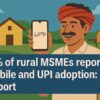International migration is expected to fall in 2020 for the first time in recent decades, as per World Bank’s ‘Migration and Development Brief’
 As the covid pandemic and the economic crisis continue, the amount of money migrant workers send home is projected to decline by 14% by 2021, compared to the pre-covid levels in 2019, according to the latest estimates published in the World Bank’s ‘Migration and Development Brief.’
As the covid pandemic and the economic crisis continue, the amount of money migrant workers send home is projected to decline by 14% by 2021, compared to the pre-covid levels in 2019, according to the latest estimates published in the World Bank’s ‘Migration and Development Brief.’
Remittance flows to low and middle-income countries (LMICs) are projected to fall by 7%, to $508 billion in 2020, followed by a further decline of 7.5%, to $470 billion in 2021. The foremost factors driving the decline in remittances include weak economic growth and employment levels in migrant-hosting countries, weak oil prices, and depreciation of the currencies of remittance-source countries against the US dollar. The importance of remittances as a source of external financing for LMICs is expected to amplify in 2020, even with the expected decline. Remittance flows to LMICs touched a record high of $548 billion in 2019, larger than foreign direct investment flows ($534 billion) and overseas development assistance (about $166 billion).
“The impact of covid is pervasive when viewed through a migration lens as it affects migrants and their families who rely on remittances,” says Mamta Murthi, Vice President for Human Development and Chair of the Migration Steering Group of the World Bank. “The World Bank will continue working with partners and countries to keep the remittance lifeline flowing, and to help sustain human capital development,” she adds.
REGIONAL REMITTANCE TRENDS
The declines in 2020 and 2021 will affect all regions, with the steepest drop expected in Europe and Central Asia (by 16% and 8%, respectively), followed by East Asia and the Pacific (11% and 4%), the Middle East and North Africa (8% and 8%), Sub-Saharan Africa (9% and 6%), South Asia (4% and 11%), and Latin America and the Caribbean (0.2% and 8%). India, China, Mexico, the Philippines, and Egypt continue to be top recipients of foreign remittances in 2020. Migrant remittance inflows to India have risen to $83.33 billion in 2019 and then declined to $75.9 billion in 2020. These inflows have increased from $2.76 billion in 1980 to $12.88 billion in 2000 to $53.48 billion in 2010. Remittances as a share of India’s GDP in 2020 is 2.9%.
“Migrants are suffering greater health risks and unemployment during this crisis,” says Dilip Ratha, lead author of the brief and head of KNOMAD, the global Knowledge Partnership on Migration and Development. “The underlying fundamentals driving remittances are weak and this is not the time to take our eyes off the downside risks to the remittance lifelines,” says he. For the first time in recent history, the stock of international migrants is likely to decline as new migration has slowed and return migration has increased. Return migration has been reported in all parts of the world following the lifting of national lockdowns, which left many migrant workers stranded in host countries.
BANKS: COSTLIEST CHANNEL
According to the World Bank’s Remittance Prices Worldwide Database, the global average cost of sending $200 was 6.8% in the third quarter of 2020, largely unchanged since the first quarter of 2019. The cost was the lowest in South Asia (5%) and highest in Sub-Saharan Africa (8.5%).
Banks are the costliest channel for sending remittances, averaging 10.9%, followed by post offices at 8.6%, money transfer operators at 5.8%, and mobile operators at 2.8%. Despite being the cheapest, money transfer and mobile operators face increasing hurdles as banks close their accounts to reduce risk of non-compliance with anti-money laundering (AML) and combating terrorism financing (CFT) standards. To keep these channels open, especially for lower-income migrants, AML/CFT rules could be temporarily simplified for small remittances. Further, strengthening mobile money regulations and identity systems will improve transparency of transactions. Facilitating digital remittances would require improving access to bank accounts for mobile remittance service providers as well as senders and recipients of remittances.
NEED TO SUPPORT MIGRANTS
“Beyond humanitarian considerations, there is a strong case to support migrants who work with host communities on the frontline in hospitals, labs, farms, and factories,” said Michal Rutkowski, Global Director of the Social Protection and Jobs Global Practice at the World Bank. “Supportive policy responses by host countries should include migrants, while origin or transit countries should consider measures to support migrants returning home,” he added.
The World Bank Group is making available up to $160 billion over a 15-month period ending June 2021 to help more than 100 countries protect the poor and vulnerable, support businesses, and bolster economic recovery.
There is a pressing need to improve relevant data collection systems. The crisis has exposed significant data gaps that have prevented real time monitoring of remittance flows and migratory movements including stranded migrants and returning migrants.







